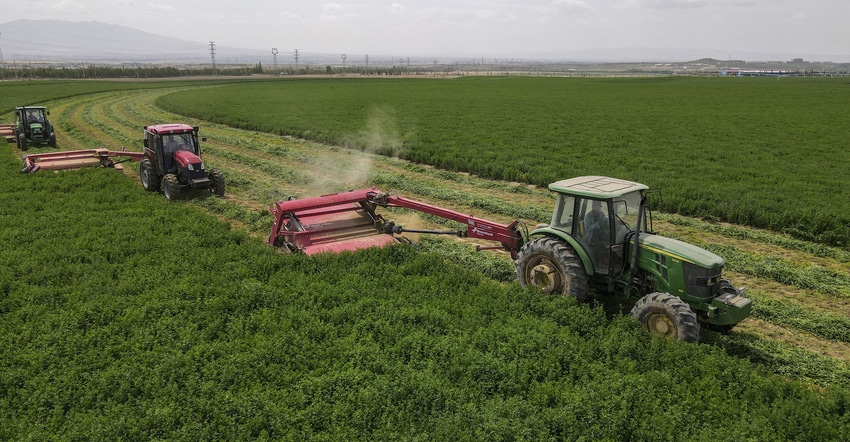June 20, 2022

Alfalfa is known as the queen of forages for its ability to produce incredible amounts of high-protein forage in an array of different environments. Proper management of alfalfa stands can help producers maintain the highest-quality and highest-yielding alfalfa for their livestock enterprises.
In Ohio, alfalfa thrives in the state’s growing conditions, and producers can potentially harvest five times in a growing season. For maximum yield and a healthy alfalfa stand, proper soil fertility is crucial.
Soil tests are crucial in understanding which nutrients are deficient, and with the price of fertilizer and high-quality alfalfa, it is important to know if producers are applying too much or not enough fertilizer.
Soil pH
The highest-yielding alfalfa is grown in soil with a pH of 6.7. In southeastern Ohio, soils tend to have low soil pH, so applications of lime are regularly needed.
Soil pH plays a large role in alfalfa stand longevity and plant density. Low pH can have a negative effect on yield, as acidic soil reduces the effectiveness of rhizobia bacteria to create nitrogen for the plant, whereas higher pH does not affect yields in alfalfa. If soil pH is below 6.7, lime should be applied to raise pH.
In addition to low pH decreasing yield, low pH also reduces crude protein and increases fiber content. This adds to an overall decrease in alfalfa hay quality.
Nitrogen
Alfalfa is a nitrogen-fixing legume, meaning that through nodulation in the roots from rhizobia bacteria, N is produced naturally for the plant to use.
An application of N is not recommended in alfalfa production. Seeds will be inoculated with the N-fixing bacteria before planting.
Phosphorus
Phosphorus is the most yield-limiting nutrient in alfalfa, meaning yield is in direct correlation with P availability to the plant. Desired P levels should be at least 15 parts per million before alfalfa is seeded.
Each ton of alfalfa harvested can remove 14 pounds of phosphorus pentoxide (P205) from the soil, so soil samples should be taken annually to know if a P205 application is needed.
P deficiency can simply look like reduced yields, as well as stunted plants and chlorosis. P205 can be broadcasted and incorporated before seeding, or as a topdressing on established stands.
Potassium
Potassium is the most important nutrient for alfalfa’s ability to overwinter without experiencing plant death. K deficiencies can look like winterkill, as well as yellowing on the outside of leaves toward the top of the plant.
Each ton of alfalfa removed can take 60 pounds of potassium oxide (K2O) with it, so annual soil samples should be taken to know if a potash application is needed. K2O, like the P205 application, can be broadcasted and incorporated before seeding, or topdressed to established stands.
Field location or seedbed
Well-drained soils are a must in alfalfa production, so field selection is going to be a major contributor in alfalfa stand health, longevity and yield. Many diseases in alfalfa can be avoided by choosing a well-drained location.
A firm seedbed is needed in growing alfalfa. Good seed-to-soil contact needs to be made for best germination rates. In addition, proper tillage can help in controlling perennial and annual weeds.
Most successful stands will be established using primary and secondary tillage such as a moldboard plow or chisel plow, followed by a disk or rototiller and use of a cultipacker to firm the soil. Best soil conditions will be smooth and firm, and free of clumps.
With the cost of inputs this year, it can be daunting to look at the fertility needs of alfalfa to ensure a good harvest and maintain alfalfa stand health. For this reason, producers should focus primarily on soil pH and utilization of lime if they have low-pH issues in their soil.
With a low pH, a fertilizer application may not be used fully, and will not be beneficial for your alfalfa crop or for your billfold this year. Looking at correcting soil pH before a fertilizer application does not just apply to years when fertilizer prices are high, but this year there also should be a clear emphasis made on pH before your money is spent on fertilizer — if your soil test comes back and you are not deficient in P or K.
Lime applications do not amend soil pH immediately. Producers that apply lime this year will see improvement in pH in the following year. This being said, fertilizer prices will most likely remain high next year.
Warner is the OSU Extension ag and natural resources educator in Scioto County. He is also a member of the OSU Extension Beef Team that publishes the weekly Ohio BEEF Cattle letter, which can be found at beef.osu.edu.
You May Also Like




